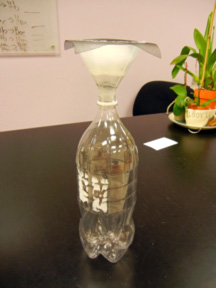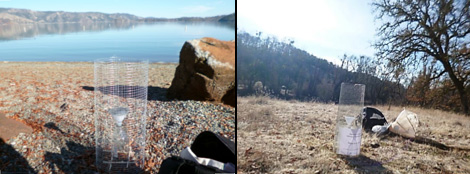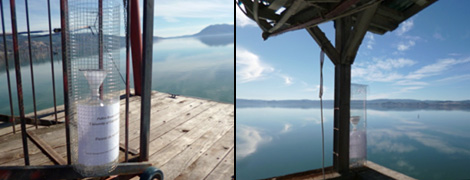Pollen analysis (or palynology) has been used to study Quaternary changes in vegetation and climate in North America since the nineteenth century. Palynologists generally compare plant assemblages in spatial-time frames instead of focusing on particular plant species. These changes in plant assemblages across landscapes through time are a good indication of vegetation shifts caused by environmental changes. Besides using pollen assemblages to reconstruct parent plant communities in a particular area, certain species, which are sensitive to changes in temperature or precipitation, are of special interest. By comparing assemblages of plant communities and these indicative species through time and space, we can infer how regional flora responded to environmental changes such as changes in climate.
Before comparing these past assemblages of plant communities and inferring environmental changes, palynologists carefully consider the processes leading to pollen accumulation. Do their pollen and spore assemblages accurately reflect local or more regional vegetation? Are certain pollen types over- or underrepresented? Does the assemblage include the majority of taxa present in the local plant communities? Pollen assemblages are incorporated in sediments at the end of a long taphonomic pathway, and are affected by temporal and quantitative aspects of pollen and spore production, differential dispersal characteristics, secondary transport, and other taphonomic processes.
How could we get hints of that process throughout geologic time? Wind-pollinated assemblages are most often transported and they are usually produced in large amounts and have wider dispersal ranges. To study the taphonomic process of pollen and spores, palynologists often use surface samples to research the discrepancy between vegetation composition and pollen assemblages. Such analysis also might help to understand the taphonomic conditions in the sample area and provide a reference point for a regional paleopalynological study.

For my dissertation research, I am compiling a California pollen reference collection. Focused on the last interglacial period, I plan to reconstruct the vegetation from a relatively warm period during that time interval. My methods involve extracting pollen from core samples from Clear Lake. Clear Lake is the largest lake in California with a sedimentary record going back at least to the last interglacial period (~130 ka) (see Scientists core into Clear Lake to explore past climate change). The microscopic pollen grains are expected to yield important clues on the history of vegetation communities and the taphonomic process surrounding Clear Lake; data from pollen traps set in different vegetation areas in the vicinity of the lake — forests up to 2 km from the lake, or small, more distant upstream communities — will enable further analysis of modern vegetation types.
The most common pollen in Clear Lake samples is wind-pollinated, mostly pine and oak pollen. An important question is: does this pollen mainly originate from the northwestern forests, the southwestern forests, or other adjacent places? To solve this question, I started to look for appropriate types of pollen traps to collect surface samples and, with the help of my undergrads, Mary Grace Rodriguez and Rebecca Shirsat, we built some traps to position in the field.
After visiting the Clear Lake area a couple of times, I positioned the first 10 pollen traps close to the lake — many thanks to Carolyn Ruttan from Lake County Water Resources who helped me obtain landowners’ permits for this.
The first time doing field research is often filled with anticipation. On January 20, I left Berkeley in the early morning. I was so excited — not only because I could finally install my pollen traps, but because it would be only my second time driving through winding mountain roads!
After meeting Carolyn Ruttan I set off to Clear Lake State Park, our first pollen trap site. I selected a rocky corner of the lake that had a gorgeous view. Securing this first pollen trap to the ground was a challenge, but we stabllized the base with pebbles and used a small iron wire to prevent the trap from blowing over in the wind.
The next trap was easier to position, being on soft soil in Anderson Marsh. We only had to avoid picking a spot where weeds might cover the area later in the year.
The Lake County Land Trust’s Rodman Preserve is another one of my research sites. The trust was formed as a non-profit organization in 1994 and it works to protect important land resources, wetlands, forests, etc., in Lake County, CA.

The Elem Indian Colony, near Clearlake Oaks on the eastern shore of Clear Lake, is my fourth research site. It is a Native American colony of Pomo, associated with the Sulphur Bank Rancheria. The residents were friendly and curious about our purpose. I am sure they will help prevent tourists from removing the trap that we placed near a power station.
We then attached pollen traps to railings and floating platforms at three sites. Installation of the first 10 pollen traps was completed on this first trip; we went back two weeks later to complete the west side of the lake.

The most serious threat to my traps is the strong winds around Clear Lake, especially on the northwest side. Strong, seasonal winds can take down deeply-rooted trees and it could damage the pollen traps. Squirrels and birds might also be a problem but hopefully, the iron wires we used will keep them safe from animals. I plan to return to Clear Lake later in the year to replace trap materials and to see what my pollen traps have collected (if the squirrels and birds have not absconded with my trap materials)!